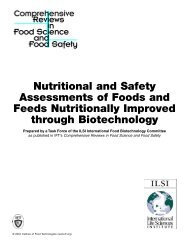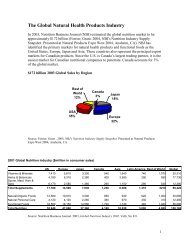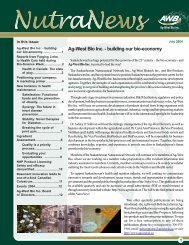Beyond Borders: Global biotechnology report 2010
Beyond Borders: Global biotechnology report 2010
Beyond Borders: Global biotechnology report 2010
Create successful ePaper yourself
Turn your PDF publications into a flip-book with our unique Google optimized e-Paper software.
The momentum continued to build in the<br />
second half of the year, with a boost from<br />
more good news on the clinical trial front,<br />
this time from Human Genome Sciences<br />
(HGS). In the second six months of the<br />
year, capital raised through US follow-on<br />
public equity offerings increased more than<br />
threefold. However, this financing rebound<br />
did not extend to all companies equally. In<br />
fact, three companies — HGS, Dendreon and<br />
Vertex Pharmaceuticals — accounted for 44%<br />
of the more than US$5 billion raised through<br />
US follow-on offerings in the second half of<br />
the year. In Europe, follow-on fund-raising<br />
was even more skewed, with one transaction<br />
by QIAGEN accounting for 77% of Europe’s<br />
follow-on funding for the entire year.<br />
Despite this concentration, increased<br />
investor interest in offerings by existing<br />
public companies can be an early indicator<br />
of the return of the IPO market. Indeed,<br />
four IPOs were completed in the US and<br />
Europe in the second half, although two<br />
were by profitable companies and a third<br />
was by a company preparing to launch<br />
an approved product. Still, many others<br />
started queuing up to test the IPO waters<br />
in <strong>2010</strong>. As we go to press in April, seven<br />
US companies have completed IPOs, while<br />
several are in the queue. No European<br />
companies have gone public so far in<br />
<strong>2010</strong>, and only one has filed to do so. The<br />
most significant debut was by Ironwood<br />
Pharmaceuticals. The company raised<br />
about US$215 million at a US$1 billion<br />
post-money valuation with significant<br />
support from existing investors. In a sign<br />
of the times, most companies in the IPO<br />
queue are more mature than the typical<br />
IPO candidate of four or five years ago.<br />
While this presents a challenge for venture<br />
investors seeking timely exits, it is a plus for<br />
IPO investors seeking less risky investments.<br />
As the global financial environment<br />
improves, we expect the appetite for IPOs<br />
to increase, but we anticipate that the bar<br />
placed by investors will remain high.<br />
Public investors are not the only ones<br />
raising the bar on their investments. In<br />
Europe, venture investing fell 21%, with total<br />
venture capital falling to the lowest level of<br />
the decade. The year was one of only two<br />
years when the industry raised less than<br />
€1 billion (US$1.4 billion). For companies<br />
that did succeed in raising venture capital,<br />
it frequently came at a lower valuation than<br />
the previous funding round.<br />
There were a number of causes for this<br />
decline in venture investing. Profitable exits,<br />
either via the public market or through<br />
acquisition, remain challenging, and VCs<br />
understand that they will have to reserve<br />
more capital to fund their existing portfolio<br />
companies longer. As a result, investors<br />
are being more and more selective in the<br />
types of technologies and therapies they<br />
are willing to back, favoring those that are<br />
most likely to interest a big pharma or big<br />
biotech buyer within a reasonable period<br />
of time. In addition, while some prominent<br />
firms such as NEA, Index Ventures and<br />
Domain, were able to close significant<br />
new funds in 2009, the National Venture<br />
Capital Association <strong>report</strong>s that overall<br />
inflows into the US venture capital industry<br />
declined by 47% in 2009 to the lowest<br />
level since 2003. A similar phenomenon<br />
occurred in Europe, with some specialized<br />
life sciences funds seeking liquidity in their<br />
existing portfolio investments in order to<br />
demonstrate the returns necessary to raise<br />
new capital. While some of the lower capital<br />
inflows were the result of firms choosing<br />
to stay on the sidelines in a difficult year,<br />
<strong>2010</strong> promises to continue to present a<br />
challenging fund-raising environment, with<br />
the net result being fewer venture funds and<br />
lower amounts of investable capital across<br />
the industry.<br />
These challenges are driving changes in<br />
the biotech investment model itself. VCs<br />
are experimenting with new investment<br />
strategies, including funding projects<br />
to important value-inflection points for<br />
eventual sale to a larger company, rather<br />
than building stand-alone companies with<br />
the attendant infrastructure. As a result,<br />
we may see a continued decline in total<br />
capital invested, but perhaps not in the<br />
number of products under development.<br />
Companies are still likely to be built around<br />
innovative platform technologies, whereas<br />
product stories with more binary outcomes<br />
will increasingly fall under these new<br />
models. And where will all these product<br />
candidates come from? In large part from<br />
65








